As a homeowner, you have some responsibility to yourself to protect your investment. There are a few things that you should do every year right before the first signs of frost.
Below is a list of the areas that you should focus on to help you get better prepared for the winter weather.
#1.Clean Rain Gutters
 A dirty or clogged rain gutter could cause water to overflow and pour down against the home and onto the foundation. This extra water will seep into the ground and possibly find its way into the basement through cracks or small holes.
A dirty or clogged rain gutter could cause water to overflow and pour down against the home and onto the foundation. This extra water will seep into the ground and possibly find its way into the basement through cracks or small holes.
It’s a good idea to check your rain gutters at least once or twice during the season, but especially in the fall when you have trees shedding leaves that could end up on your roof.
One other thing to look for while inspecting your rain gutters is to check and make sure that they are level. If you are unsure, you can take a look outside during a rainstorm to see if there is any water flowing over the edges of the gutter. If you see water overflowing, take note of where that is and wait until the storm has passed before attempting to fix it.
#2. Check The Sump Pump
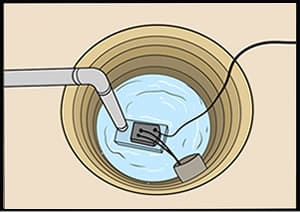 A properly working sump pump is a very valuable piece of equipment that should never get overlooked.
A properly working sump pump is a very valuable piece of equipment that should never get overlooked.
Take a look in the sump pit and make sure that no debris could be sucked up into the inlet to block the pump from working correctly. Next, double-check that the sump pump is working correctly by taking a bucket or two of water and dumping it down into the sump pit. You do not want to manually switch the pump on without any water in the pit in case you burn out the pump.
Once the water has pumped out of the pit, take a walk outside and make sure that the hose or pipe is flowing downward and away from the foundation. If the water is not draining out properly, you run the risk of having the water freeze in the pipe and cause a blockage.
#3. Seal Foundation Cracks
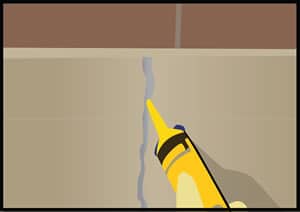 Take a walk around your home and look for any visible cracks in the foundation. Cold weather can make any size of a crack worse. When rainwater runs down, and into the crack, it’ll sit and pool inside, and then when the temperatures drop below freezing, it’ll cause that water to freeze and expand, which will open the crack up more and cause the crack to expand.
Take a walk around your home and look for any visible cracks in the foundation. Cold weather can make any size of a crack worse. When rainwater runs down, and into the crack, it’ll sit and pool inside, and then when the temperatures drop below freezing, it’ll cause that water to freeze and expand, which will open the crack up more and cause the crack to expand.
If you notice any cracks in the foundation, you should immediately look at repairing the problem or call in a professional to handle it for you. The longer you leave it, the worse it’ll get. Not to mention, if a crack is allowing water to seep into the basement, this could turn into a severe mold problem. It is better to tackle these cracks as soon as you notice them.
#4. Inspect and Insulate Pipes
 Inspect water lines for any signs of cracks. Even though you might not have a problem with water leaking from a crack if the water in the pipe were to freeze it’ll cause the water to expand and put pressure on the crack which will widen it. Even a tiny crack could become a huge problem.
Inspect water lines for any signs of cracks. Even though you might not have a problem with water leaking from a crack if the water in the pipe were to freeze it’ll cause the water to expand and put pressure on the crack which will widen it. Even a tiny crack could become a huge problem.
Any pipes that run along or through an outside wall should be properly insulated. If you have an unfinished basement and you are not able to keep it warm, you could try wrapping the pipes with a heating cable to help keep the water in the pipes from freezing.
#5. Seal Off Gaps
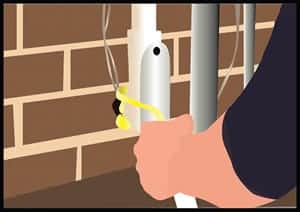 Take a look around your basement at the outside walls and windows, and look for any cracks or gaps. Check where pipes or vents exit the home, as well as the seal around any windows or pipes. Often, over time the caulking or sealant used to seal gaps will dry out and sometimes crack and fall off. When this happens, it’ll expose an opening which will allow for cold air to come in.
Take a look around your basement at the outside walls and windows, and look for any cracks or gaps. Check where pipes or vents exit the home, as well as the seal around any windows or pipes. Often, over time the caulking or sealant used to seal gaps will dry out and sometimes crack and fall off. When this happens, it’ll expose an opening which will allow for cold air to come in.
If you notice any dried up caulking that is cracking, the best thing to do is take a screwdriver and a hammer and chisel away the old caulking. Use a silicone sealant caulk to fill in where the old caulking was. To fill in any cracks in the concrete you can use a polyurethane caulk, that will work best. Silicone will also work.
#6. Inspect Foundation For Pooling Water
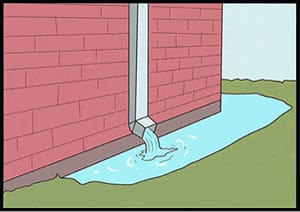 After, or during a rainstorm, take a walk around the home and inspect the foundation for any areas where water is sitting or pooling near the home. Make a note of these spots so that when it’s finished raining, you can fill those areas in with dirt to create a slope. The idea is to make sure that the water is flowing away from your home and to prevent it from sitting next to it.
After, or during a rainstorm, take a walk around the home and inspect the foundation for any areas where water is sitting or pooling near the home. Make a note of these spots so that when it’s finished raining, you can fill those areas in with dirt to create a slope. The idea is to make sure that the water is flowing away from your home and to prevent it from sitting next to it.
Double-check that your downspouts are at least 6 feet away from your home and directing water away from the foundation.
#7. Clean Fireplace and Chimney
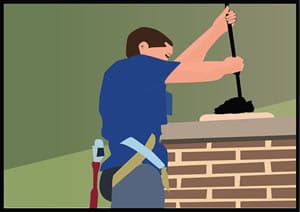 Before you light your first fire of the season, you should first clean out any soot and debris from the chimney that could catch fire. That goes for any little critters that might have made a nest in there. A clogged chimney could be very dangerous.
Before you light your first fire of the season, you should first clean out any soot and debris from the chimney that could catch fire. That goes for any little critters that might have made a nest in there. A clogged chimney could be very dangerous.
To help keep the warm air in your home from escaping up the chimney when you’re not using the fireplace, you should keep the flue closed all the way. You shouldn’t be able to feel any cool air whatsoever coming down the chimney.
#8. Shovel Snow and Ice Away From Foundation
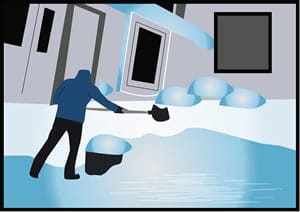 After a big snowfall or ice storm, you should get outside and shovel the snow and ice away from the foundation right away. You do not want to leave the ice or snow to melt and run down into any cracks in the concrete foundation because once that water freezes again in those cracks, it’ll expand and cause the cracks to worsen.
After a big snowfall or ice storm, you should get outside and shovel the snow and ice away from the foundation right away. You do not want to leave the ice or snow to melt and run down into any cracks in the concrete foundation because once that water freezes again in those cracks, it’ll expand and cause the cracks to worsen.
Keeping the snow and ice from building up next to the foundation will also help reduce the amount of moisture in your basement.
How Cold Can Basements Get Before Pipes Freeze?
Anyone who has ever had a pipe freeze and burst during the winter knows how much damage that can cause. That is why it is important to make sure your basement doesn’t get too cold. But how cold is too cold? Experts say that once your basement reaches 5 degrees Fahrenheit, that’s when you need to start to be concerned.
Pipes that are on an outside wall without the proper insulation are more likely to freeze.
Should I Heat The Basement?
During the winter months, you do want to heat your basement, even if you don’t plan on using that space. The most important reason why you would want to heat your basement is to help reduce the amount of moisture build upon the foundation walls.
Let me explain why that is a bad thing. If you do not heat your basement, when the warmer air within the home comes in contact with the cold foundation walls, it’ll create condensation on the walls which could turn into mold or mildew.
Now, if you heat your basement, those walls will remain warm which will reduce the chances that any condensation will form.
One other benefit to keeping your basement warm is that it will ultimately help you save money over the winter. I know what you are thinking, how can you save money when you are adding extra square footage to be heated?
You see, when your basement is cold, that cold air will find any little crack or gap to escape out of, and when it does, it’ll end up bringing in more cold air from outside. That extra cold air will begin to make the upstairs feel colder, which will make you want to turn the furnace up higher. Also, the furnace will continue to run more frequently. Hence the higher electric bill.
